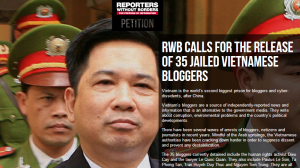Vietnam is facing a growing population, increasing pollution, extreme weather events and challenges in implementing effective national policies, Thang Do writes.
Vietnam is facing many water challenges. Despite having about 2,000 millimetres rainfall on average per year, water availability is highly seasonal and unevenly distributed across the country. Water scarcity has become severe in many regions. A devastating drought in the Mekong Delta and Central Highlands in 2016 caused losses of US $700 million and impacted more than two million people.
With a growing population of over 90 million people and rapid industrialisation and urbanisation, surface and groundwater are being overexploited. Stark trade-offs are emerging in water allocation for irrigation, industry, and households.
The supply of water is also dwindling as water pollution increases from urban areas and industrial zones. Only 10 per cent of domestic wastewater and 25 per cent of industrial wastewater is treated before being discharged into rivers. Untreated wastewater has created dead rivers and lakes in and around big cities and industrial zones, undermining the health and livelihoods of millions of people.
Water scarcity and pollution are being exacerbated by climate change and upstream hydropower development. It is estimated that a sea level riseof one metre by the end of this century will displace about 11 per cent of the population, mainly in the Red River Delta and the Mekong River Delta and along 3,000 kilometres of the coast.
Recent severe typhoons and storm surges, as well as other extreme weather eventssuch as drought and flash floods, have cost around US $1.75 billion. In addition, more flooding in the rainy season and severe drought in the dry season has been a problem recently in the Mekong Delta, a region where 50 per cent of Vietnam’s rice is produced. In 2016, for the first time, saline waterreached up to 100 kilometres inland, damaging crops and contaminating drinking water sources.
Vietnam’s water crises are becoming more and more severe despite the Government responding with a series of policy measures, including issuing the 2012 Law on Water Resources and the 2014 Law on Environmental Protection. The aim of the Law on Water Resources is to provide a legal basis for the management, protection, exploitation and use of water resources, as well as for the prevention, control and remedy of harmful effects caused by water. The 2014 Law on Environmental Protection governs environmental protection activities, including water environment protection.
Part of the problem is that water policy development and implementation are fragmented across national ministries. The Ministry of Natural Resources and Environment (MONRE) was established in 2002 to separate policy development and regulation of water resources from ministries overseeing the exploitation and use of water resources for economic development, such as the Ministry of Agriculture and Rural Development (MARD) and Ministry of Industry and Trade (MOIT).
But there is limited coordination between MONRE, other national ministries, and provincial governments. For example, commissions for environmental protection were established in three major river basins(Cau, Nhue-Day and Dong Nai-Sai Gon) in 2006 but have struggled to accomplish their targets.
Vietnam urgently needs to review its water governance to identify shortcomings and develop solutions.
One problem in need of a solution is the question of which model of river basin management is most suitable for the country. Although a national decree on river basin management was issued in 2008, its implementation has been fairly slow. Several different models have been proposed, but are yet to be approved by the government.
In Vietnam, water left in rivers and streams for the benefit of the environment is not explicitly recognised nor properly provided. This means that this environmental water receives low priority in water allocation decisions.
On top of that, insufficient enforcement of water quality standards has resulted in rivers and lakes becoming a dumping ground for waste. A review of current regulations is needed in Vietnam to legally recognise the importance of environmental water.
Without information on the value of water resources and water uses, the administrative allocation of water in Vietnam is mainly based on limited biophysical information. As a result, it typically does not provide an optimal allocation of water nor incentives to use water efficiently.
Although the concept of environmental values has been acknowledged through national law, in practice researchers and officials have limited capacity to perform valuation exercises and share results with policymakers.
Water valuation, therefore, will be a helpful tool for efficient water allocation and managing the trade-offs between environmental sustainability and economic development. It will also follow the direction of more application of market-based instruments in water management that has been set out in recent water policies.
While Vietnam is facing critical water issues that prevent it from achieving the Sustainable Development Goals, it can learn from other countries’ experiences in water management – including Australia through its recently signed Strategic Partnership. Three key areas of the expertise transfer are river basin management organisation, legal recognition of the environment’s share of water, and value-based water allocation.
International cooperation could enable major progress in Vietnam, and ensure that it’s more than just good ideas on water management that flow into the country.
Height Insoles: Hi, I do believe this is an excellent site. I stumbledupon …
http://fishinglovers.net: Appreciate you sharing, great post.Thanks Again. Keep writi…
Achilles Pain causes: Every weekend i used to pay a quick visit this site, as i w…






April 17, 2018
Vietnam’s challenges to go with the flow
by Nhan Quyen • [Human Rights]
Tackling the country’s stark water trade-offs
Thang Nam Do, Policy Forum, ngày 16/4/2018
Vietnam is facing a growing population, increasing pollution, extreme weather events and challenges in implementing effective national policies, Thang Do writes.
Vietnam is facing many water challenges. Despite having about 2,000 millimetres rainfall on average per year, water availability is highly seasonal and unevenly distributed across the country. Water scarcity has become severe in many regions. A devastating drought in the Mekong Delta and Central Highlands in 2016 caused losses of US $700 million and impacted more than two million people.
With a growing population of over 90 million people and rapid industrialisation and urbanisation, surface and groundwater are being overexploited. Stark trade-offs are emerging in water allocation for irrigation, industry, and households.
The supply of water is also dwindling as water pollution increases from urban areas and industrial zones. Only 10 per cent of domestic wastewater and 25 per cent of industrial wastewater is treated before being discharged into rivers. Untreated wastewater has created dead rivers and lakes in and around big cities and industrial zones, undermining the health and livelihoods of millions of people.
Water scarcity and pollution are being exacerbated by climate change and upstream hydropower development. It is estimated that a sea level riseof one metre by the end of this century will displace about 11 per cent of the population, mainly in the Red River Delta and the Mekong River Delta and along 3,000 kilometres of the coast.
Recent severe typhoons and storm surges, as well as other extreme weather eventssuch as drought and flash floods, have cost around US $1.75 billion. In addition, more flooding in the rainy season and severe drought in the dry season has been a problem recently in the Mekong Delta, a region where 50 per cent of Vietnam’s rice is produced. In 2016, for the first time, saline waterreached up to 100 kilometres inland, damaging crops and contaminating drinking water sources.
Vietnam’s water crises are becoming more and more severe despite the Government responding with a series of policy measures, including issuing the 2012 Law on Water Resources and the 2014 Law on Environmental Protection. The aim of the Law on Water Resources is to provide a legal basis for the management, protection, exploitation and use of water resources, as well as for the prevention, control and remedy of harmful effects caused by water. The 2014 Law on Environmental Protection governs environmental protection activities, including water environment protection.
Part of the problem is that water policy development and implementation are fragmented across national ministries. The Ministry of Natural Resources and Environment (MONRE) was established in 2002 to separate policy development and regulation of water resources from ministries overseeing the exploitation and use of water resources for economic development, such as the Ministry of Agriculture and Rural Development (MARD) and Ministry of Industry and Trade (MOIT).
But there is limited coordination between MONRE, other national ministries, and provincial governments. For example, commissions for environmental protection were established in three major river basins(Cau, Nhue-Day and Dong Nai-Sai Gon) in 2006 but have struggled to accomplish their targets.
Vietnam urgently needs to review its water governance to identify shortcomings and develop solutions.
One problem in need of a solution is the question of which model of river basin management is most suitable for the country. Although a national decree on river basin management was issued in 2008, its implementation has been fairly slow. Several different models have been proposed, but are yet to be approved by the government.
In Vietnam, water left in rivers and streams for the benefit of the environment is not explicitly recognised nor properly provided. This means that this environmental water receives low priority in water allocation decisions.
On top of that, insufficient enforcement of water quality standards has resulted in rivers and lakes becoming a dumping ground for waste. A review of current regulations is needed in Vietnam to legally recognise the importance of environmental water.
Without information on the value of water resources and water uses, the administrative allocation of water in Vietnam is mainly based on limited biophysical information. As a result, it typically does not provide an optimal allocation of water nor incentives to use water efficiently.
Although the concept of environmental values has been acknowledged through national law, in practice researchers and officials have limited capacity to perform valuation exercises and share results with policymakers.
Water valuation, therefore, will be a helpful tool for efficient water allocation and managing the trade-offs between environmental sustainability and economic development. It will also follow the direction of more application of market-based instruments in water management that has been set out in recent water policies.
While Vietnam is facing critical water issues that prevent it from achieving the Sustainable Development Goals, it can learn from other countries’ experiences in water management – including Australia through its recently signed Strategic Partnership. Three key areas of the expertise transfer are river basin management organisation, legal recognition of the environment’s share of water, and value-based water allocation.
International cooperation could enable major progress in Vietnam, and ensure that it’s more than just good ideas on water management that flow into the country.